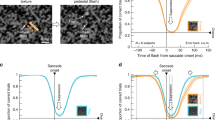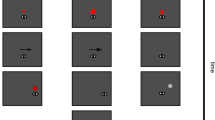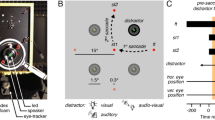Abstract
The frequent occurrence of saccadic eye movements raises the question of how information is combined across separate glances into a stable, continuous percept. Here I show that visual form processing is altered at both the current fixation position and the location of the saccadic target before the saccade. When human observers prepared to follow a displacement of the stimulus with the eyes, visual form adaptation was transferred from current fixation to the future gaze position. This transfer of adaptation also influenced the perception of test stimuli shown at an intermediate position between fixation and saccadic target. Additionally, I found a presaccadic transfer of adaptation when observers prepared to move their eyes toward a stationary adapting stimulus in peripheral vision. The remapping of visual processing, demonstrated here with form adaptation, may help to explain our impression of a smooth transition, with no temporal delay, of visual perception across glances.
This is a preview of subscription content, access via your institution
Access options
Subscribe to this journal
Receive 12 print issues and online access
$209.00 per year
only $17.42 per issue
Buy this article
- Purchase on Springer Link
- Instant access to full article PDF
Prices may be subject to local taxes which are calculated during checkout



Similar content being viewed by others
References
Robinson, D.A. The mechanics of human saccadic eye movements. J. Physiol. (Lond.) 174, 245–264 (1964).
Carpenter, R.H.S. Movements of the Eyes 2nd edn. (Pion, London, 1988).
O'Regan, J.K., Rensink, R.A. & Clark, J.J. Change-blindness as a result of 'mudsplashes'. Nature 398, 34 (1999).
McConkie, G.W. & Zola, D. Is visual information integrated across successive fixations in reading? Percept. Psychophys. 25, 221–224 (1979).
Duhamel, J.R., Colby, C.L. & Goldberg, M.E. The updating of the representation of visual space in parietal cortex by intended eye movements. Science 255, 90–92 (1992).
Kusunoki, M. & Goldberg, M.E. The time course of perisaccadic receptive field shifts in the lateral intraparietal area of the monkey. J. Neurophysiol. 89, 1519–1527 (2003).
Nakamura, K. & Colby, C.L. Updating of the visual representation in monkey striate and extrastriate cortex during saccades. Proc. Natl. Acad. Sci. USA 99, 4026–4031 (2002).
Galletti, C., Battaglini, P.P. & Fattori, P. Parietal neurons encoding spatial locations in craniotopic coordinates. Exp. Brain Res. 96, 221–229 (1993).
Duhamel, J.R., Bremmer, F., BenHamed, S. & Graf, W. Spatial invariance of visual receptive fields in parietal cortex neurons. Nature 389, 845–848 (1997).
d'Avossa, G. et al. Spatiotopic selectivity of BOLD responses to visual motion in human area MT. Nat. Neurosci. 10, 249–255 (2007).
Georgeson, M.A. Psychophysical hallucinations of orientation and spatial frequency. Perception 5, 99–111 (1976).
Blakemore, C. & Campbell, F.W. On the existence of neurones in the human visual system selectively sensitive to the orientation and size of retinal images. J. Physiol. (Lond.) 203, 237–260 (1969).
Parker, D.M. Contrast and size variables and the tilt after-effect. Q. J. Exp. Psychol. 24, 1–7 (1972).
He, S. & MacLeod, D.I. Orientation selective adaptation and tilt after-effect from invisible patterns. Nature 411, 473–476 (2001).
Melcher, D. & Morrone, M.C. Spatiotopic temporal integration of visual motion across saccadic eye movements. Nat. Neurosci. 6, 877–881 (2003).
Melcher, D. Spatiotopic transfer of visual form adaptation across saccadic eye movements. Curr. Biol. 15, 1745–1748 (2005).
Merriam, E.P. & Colby, C.L. Active vision in parietal and extrastriate cortex. Neuroscientist 11, 484–493 (2005).
Sommer, M.A. & Wurtz, R.H. Influence of the thalamus on spatial vision processing in frontal cortex. Nature 444, 374–377 (2006).
Umeno, M.M. & Goldberg, M.E. Spatial processing in the monkey frontal eye fields I: predictive visual responses. J. Neurophysiol. 78, 1373–1383 (1997).
Matin, L. & Pearce, D.G. Visual perception of direction for stimuli flashed during voluntary saccadic eye movements. Science 148, 1485–1487 (1965).
Ross, J., Morrone, M.C., Goldberg, M.E. & Burr, D.C. Changes in visual perception at the time of saccades. Trends Neurosci. 24, 113–121 (2001).
Morrone, M.C., Ross, J. & Burr, D. Saccadic eye movements cause compression of time as well as space. Nat. Neurosci. 8, 950–954 (2005).
Melcher, D. Persistence of visual memory for scenes. Nature 412, 401 (2001).
Georgeson, M. Visual aftereffects: cortical neurons change their tune. Curr. Biol. 14, 751–753 (2004).
Khayat, P.S., Spekreijse, H. & Roelfsema, P.R. Correlates of transsacadic integration in the primary visual cortex of the monkey. Proc. Natl. Acad. Sci. USA 101, 12712–12717 (2004).
Acknowledgements
This research was supported by the British Academy and the Fondazione Cassa di Risparmio di Trento e Rovereto.
Author information
Authors and Affiliations
Corresponding author
Ethics declarations
Competing interests
The author declares no competing financial interests.
Supplementary information
Supplementary Fig. 1
Measurement of the functional extent of tilt adaptation for each participant. (PDF 5 kb)
Supplementary Fig. 2
Control experiment to test whether attention shifts would lead to remapping of tilt adaptation. (PDF 49 kb)
Supplementary Fig. 3
Control experiment to measure the ability of observers to perceive and report the brief test stimulus. (PDF 1905 kb)
Rights and permissions
About this article
Cite this article
Melcher, D. Predictive remapping of visual features precedes saccadic eye movements. Nat Neurosci 10, 903–907 (2007). https://doi.org/10.1038/nn1917
Received:
Accepted:
Published:
Issue Date:
DOI: https://doi.org/10.1038/nn1917
This article is cited by
-
Occipital cortex is modulated by transsaccadic changes in spatial frequency: an fMRI study
Scientific Reports (2021)
-
The behavioural preview effect with faces is susceptible to statistical regularities: Evidence for predictive processing across the saccade
Scientific Reports (2021)
-
Attentional bias towards negative stimuli in healthy individuals and the effects of trait anxiety
Scientific Reports (2020)
-
Object discrepancy modulates feature prediction across eye movements
Psychological Research (2020)
-
Distractor displacements during saccades are reflected in the time-course of saccade curvature
Scientific Reports (2018)



